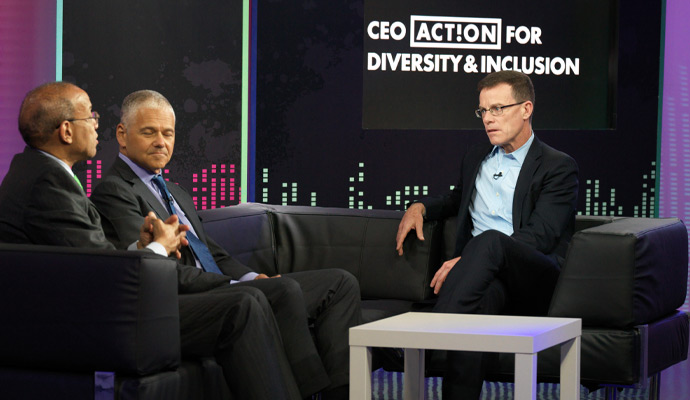Lessons of Silence
What the deaf can teach us about listening — and making ourselves heard.
In December 2006, while developing a leadership program for Airbus, I met an executive whose youngest son was born without hearing. Through this man and www.WebSourd.org, a French-language Web site that he founded to offer online sign-language translation services, I became familiar with the silent culture of deaf people. As I immersed myself in their visual, intensely expressive language, I realized that through their “handicap,” deaf people had developed certain communication skills more thoroughly than most hearing people, which made them uncommonly effective at getting their point across. Thus a radical experiment was born: to work with deaf people as communication consultants for our corporate clients. The idea was not to teach our clients sign language — although some of our deaf trainers remain convinced that such training would resolve many problems — but to help them adopt communication skills from the deaf world that would make them better colleagues and managers.
When they interact with one another, deaf people act in ways that let them communicate more rapidly and accurately than hearing people. Some of these behaviors are simple and obvious, but it’s remarkable how often hearing people do the opposite. To improve your “hearing,” consider some of these lessons from our experiences and training sessions.
1. Look people in the eye. In my initial meetings with deaf people, I used an interpreter. That in itself was a strange situation: looking at one person while listening to another. During one conversation I was struck by something a young woman had “said,” so I started to write it down in my notebook. Suddenly the atmosphere changed. I looked up and saw the woman frowning angrily at me. I asked her, through the interpreter, what was wrong. “You are being very rude,” she replied. “Why?” I asked, totally lost. “Because you cut the conversation,” she responded, explaining that when I stopped looking her in the eye, I also stopped our communication. “I apologize,” I said. “But what you just said was interesting, and I didn’t want to forget it.” Her answer was quick and sharp: “No, Bruno. You don’t write to remember. You don’t remember because you write!” I was incredulous. “What are you saying? That because you didn’t take any notes during this meeting, you will be able to remember everything?” Calmly, she answered, “That’s correct. Since I don’t write, I’m more present in the interaction and I can concentrate more. And the more I do it, the better I remember.” Ten days later, when I met this young woman again, she was able to recall not just everything we covered in the original meeting, but also the color of my shirt, tie, and even how many chairs were in the room. From that day on, I stopped taking notes during meetings and interviews. And indeed, since then, my memory has improved.
2. Don’t interrupt. Deaf people follow a very strict protocol: Only one person signs at a time. If another person tries to interrupt, the others in the group shake their right hands to signify to the “interrupter” that he or she must wait until the “speaker” is finished. This approach to communication, which at first feels slow, is in fact extremely efficient because there is much less misunderstanding to explain or recover from. Consensus and agreement are arrived at more quickly than during a typical raucous overlapping conversation. By communicating sequentially, a deaf person ensures that he or she first understands the other speaker before trying to be understood. Try this the next time you’re in a business discussion, ideally one in which there’s some tension — let the other person finish what he or she has to say, then silently count to three before responding. You will find that, in the long term, slower is faster.
3. Say what you mean, as simply as possible. Deaf people are direct. This is why people with hearing sometimes perceive sign language as blunt to the point of rudeness. It’s not. It’s just explicit. The deaf tend not to hide behind soft language, struggling to find the most diplomatic wording and hoping that the listener will be able to discern what they “really” mean. And indeed, deaf people reveal not only their thoughts, but also their feelings, both positive and negative, more clearly than hearing people do, as they express them with their whole bodies. Similarly, the deaf are often far better than hearing people at finding the most economical way to convey their message. For example, I wanted to tell one of our deaf trainers about my last trip to India. I didn’t know the sign for India, so I was forced to improvise. I tried drawing maps with my finger, and then tried to come up with gestures for cultural symbols. Suddenly, I saw a light in his eyes. With a big smile, he took his index finger and placed it between his eyebrows — his sign for the familiar Bindi adornment — asking me to confirm. So simple! I later learned that the sign for Belgium, my native country, is to wipe imaginary beer froth from the lips with the right thumb.
4. When you don’t understand something, ask. Because sign language is a constantly evolving language — and because its evolution isn’t slowed down by the need to develop a written counterpart — new signs emerge all the time. Consequently, even if they use the same national sign language, two deaf people from different parts of the same country will use words unique to their region. Aware of this, deaf people feel completely at ease saying “I don’t know” or “I don’t understand.” Those of us with hearing aren’t nearly as willing to admit confusion or lack of comprehension. We often sit silently in meetings while our colleagues use acronyms or technical jargon we don’t grasp because we think asking for clarification is a sign of weakness. Ironically, we’d rather leave a meeting clueless than risk being perceived as stupid. Many meetings conclude with some version of “So, do we all agree?” which discourages anyone from saying no or asking questions. A better approach, which encourages people to speak up, is to ask each person, individually, whether he or she would like clarification about anything that has been discussed.
5. Stay focused. We all know how difficult it is to concentrate on only one thing when the phone is ringing, e-mail alerts are pouring in, and a colleague has just stopped by. The deaf cut themselves off from any distractions, they don’t multitask, and they focus their attention entirely on the conversation. In a recent meeting with some deaf people, I presented a new workflow chart. I gave them each a document outlining the program, planning to elaborate on it as they read the material. One of them stopped me and asked if they should first read, then discuss or first discuss, then read. Doing both at the same time was impossible to them — and of course, despite what we try to do, it is also impossible for us.
These are just a few of the many communications behaviors we can learn from deaf people. But overall, the most inspiring thing about communication with deaf people — and the behavior most worth emulating — is their incredibly strong desire to exchange information efficiently and without adornment. This desire is so strong, in fact, that it often highlights how feeble, misguided, and wishy-washy our own attempts at dialogue are by comparison. It turns out that the people who are truly handicapped in communication are not necessarily those with a physical disability.![]()
Bruno Kahne is senior consultant at AirBusiness Academy, a training and research consultancy in Blagnac, France, serving the aeronautical industry.




